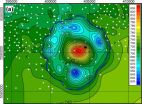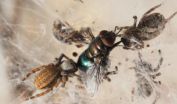(Press-News.org) EAST LANSING, Mich. — New research at Michigan State University shows that the uber-destructive emerald ash borer arrived at least 10 years before it was first identified in North America.
The study, published in the current issue of journal Diversity and Distributions, shows that EABs were feasting on ash trees in southeast Michigan by the early 1990s, well before this pest was discovered in 2002, said Deb McCullough, MSU professor of forest entomology.
"We suspect they arrived inside wood crating or pallets imported from Asia where the beetle is native," she said. "There were probably only a few live beetles that arrived, but ash trees are common in urban landscapes as well as in forests. When they emerged, there were likely ash trees nearby, providing food for the beetles and their offspring."
Slender cores were collected from the trunk of more than 1,000 ash trees across six counties in southeast Michigan. By studying the tree rings on each core and identifying key "marker" years, the team was able to determine the year each tree was killed by emerald ash borers. This study, which encompassed more than 5,800 square miles, is by far the largest area sampled with tree rings. In addition, this was the first study to use tree rings to track the spread of an invasive tree-feeding insect.
The scientists found ash trees were killed as early as 1997. Since it takes many years before the beetle population was large enough to kill ash trees, the team concluded that the invasive species had been in southeast Michigan since 1992 or 1993 and perhaps even earlier.
Emerald ash borers now have infested at least 22 states and two Canadian provinces and have become the most destructive and costly forest insect to ever invade North America, McCullough said.
"Emerald ash borers are killing trees so fast across such a large geographic area, that nobody actually knows how many trees are dead," she said. "We do know there are tens of millions of dead ash in lower Michigan alone."
Data from the tree ring study showed how the infestation grew and spread. Some of the spread was natural – adult beetles flying from one ash tree to another. However, new "satellite" populations were started by people transporting infested ash trees from nurseries or as logs and firewood. By 2003, they had expanded beyond the six counties encompassed by the tree ring study.
Part of the problem was the difficulty of detecting new infestations, said McCullough. Ash trees have no symptoms when they are first infested. By the time a tree is declining, at least three or four generations of beetles have emerged and gone off to colonize new ash trees.
In addition, reports of declining ash trees were not uncommon in Michigan and surrounding states in the 1990s. Problems ranged from road salt to drought to changing water tables. When shiny green beetles emerged from dying ash trees, however, researchers knew it was something out of the ordinary.
Specialists at the Smithsonian Institute and London's Museum of Natural History could not identify the beetles. Eventually, an entomologist in Slovakia, who intensively studied these and similar beetles, was able to identify the specimens. Still, the species had no common name until the MSU entomologists and their colleagues came up with "emerald ash borer."
By the time Michigan identified the invader, ash trees across southeast Michigan were dead or dying, McCullough said. "We think emerald ash borers probably arrived from China, where they attack only very stressed or dying ash trees. Because of that, they are not considered an important pest in China. The Asian ash species have evolved with the beetles so healthy trees there are resistant to them. In North America, emerald ash borers would still prefer to attack stressed trees but it will do fine on healthy trees, too."
INFORMATION:
The latest news is featured at http://www.emeraldashborer.info, which is housed at MSU. The site features current research, which is exploring improved methods to detect new populations as well as identifying natural enemies of emerald ash borers imported from China that may become effective biocontrol agents.
MSU researchers Nate Siegert and Frank Telewski and Andrew Liebhold of the U.S. Forest Service helped coordinate the study.
Michigan State University has been working to advance the common good in uncommon ways for more than 150 years. One of the top research universities in the world, MSU focuses its vast resources on creating solutions to some of the world's most pressing challenges, while providing life-changing opportunities to a diverse and inclusive academic community through more than 200 programs of study in 17 degree-granting colleges.
For MSU news on the Web, go to MSUToday. Follow MSU News on Twitter at twitter.com/MSUnews.
Emerald ash borers were in US long before first detection
2014-05-07
ELSE PRESS RELEASES FROM THIS DATE:
Clues about black hole formation
2014-05-07
This news release is available in Spanish.
The work, which has had the participation of the Ikerbasque researcher Javier Gorosabal, co-director of the Associated Unit with the Institute of Astrophysics of Andalusia/CSIC-UPV/EHU, has been published in the prestigious journal Nature.
There is no other event in the cosmos that can compete in terms of energy and intensity with stellar explosions on the outer reaches of the universe and which are known as LGRBs (Long Gamma-Ray Bursts): in just one second a single GRB can emit as many as hundreds of stars like the Sun ...
How businesses can maximize revenue when introducing new products
2014-05-07
BUFFALO, N.Y. — Companies should use existing brand names and add new, sub-brand names to maximize revenue when introducing new products to market, according to a new study from the University at Buffalo School of Management.
Forthcoming in Management Science, the study notes a proliferation of new products in the consumer packaged-goods market each year. For example, U.S. manufacturers introduced more than 150,000 new products in 2010 alone. Of these, more than 90 percent were extensions of existing brand-name products.
"These new products can be line extensions, like ...
Regular doctor visits may greatly diminish skin cancer deaths
2014-05-07
VIDEO:
Melody Eide, M.D., M.P.H., a Henry Ford Hospital dermatologist and the study's lead author, says regular visits to the doctor may lead to significant reductions in melanoma mortality....
Click here for more information.
DETROIT – The risk of dying from the most dangerous type of skin cancer is significantly reduced with regular doctor visits, according to a Henry Ford Hospital study.
This is believed to be the first study of its kind to link melanoma mortality with ...
For slumbering diabetics, a way to detect low blood sugar and stop insulin delivery
2014-05-07
STANFORD, Calif. — New research could soon make it easier for people with type-1 diabetes to get a safe night's sleep, says a Stanford University School of Medicine scientist who led the study.
In a large trial conducted in patients' homes in the United States and Canada, scientists demonstrated that they could predict and prevent dangerously low overnight blood sugars in adolescents and adults with type-1 diabetes.
Very low blood-sugar levels can cause seizures or even, in rare cases, death. People with type-1 diabetes often sense warning signs of low blood sugar when ...
Ancient crater points to massive meteorite strike
2014-05-07
EDMONTON—The discovery of an ancient ring-like structure in southern Alberta suggests the area was struck by a meteorite large enough to leave an eight-kilometre-wide crater, producing an explosion strong enough to destroy present-day Calgary, say researchers from the Alberta Geological Survey and University of Alberta.
The first hints about the impact site near the southern Alberta hamlet of Bow City were discovered by a geologist with the Alberta Geological Survey and studied by a U of A team led by Doug Schmitt, Canada Research Chair in Rock Physics.
Time and glaciers ...
Mapping the spider genome
2014-05-07
The fact that the eight-legged creepy spider in some ways resembles humans is one of the surprising conclusions after researchers at Aarhus University and the Beijing Genomics Institute (BGI) succeeded in sequencing its genome.
However, it is more a discovery on an awesome scale. The sequencing has far greater significance for our future understanding of the spider's special properties.
"In brief, we've acquired a tool for everyone interested in spiders," say Kristian W. Sanggaard and Jesper S. Bechsgaard, Aarhus University. Together with Xiaodong Fang, BGI, they are ...
Neural states affect learning
2014-05-07
Theta-band activity in hippocampus after an event seems to be crucial for learning. A study at the University of Jyväskylä also proved that the absence of theta facilitated learning a simple task while training during theta had no effect on learning.
Hippocampus is a brain structure that has a critical role in mammalian learning. The identification of different hippocampal states is based on the oscillatory properties of electrophysiological activity. Traditionally, rhythmic slow activity, theta, has been linked to attention, whereas transient bursts of synchronised neuronal ...
Third US National Climate Assessment reports our ecosystems are already changing
2014-05-07
The US Global Change Research Program released its Third National Climate Assessment (NCA) of the impacts of climate change on biodiversity and ecosystems this Tuesday, May 6. The NCA is the most comprehensive peer-reviewed analysis of climate change's impacts in the United States, informing Americans about the effects of climate change in their backyards.
"As an ecologist, you can't escape the effects of climate change on natural resources. We're observing climate impacts in nearly all natural and managed ecosystems," said Ecological Society of America President Jill ...
Breastfeeding promotes the growth of beneficial bacteria in the gut
2014-05-07
A number of studies have shown that breastfed babies grow slightly slower and are slightly slimmer than children who are fed with infant formula. Children who are breastfed also have a slightly lower incidence of obesity, allergies, diabetes and inflammatory bowel disease later in life. According to a new study by the National Food Institute and the University of Copenhagen this may be due to the fact that breastfeeding promotes the development of beneficial bacteria in the baby's gut.
"We have become increasingly aware of how crucially important a healthy gut microbial ...
Nanoscale heat flow predictions
2014-05-07
Physicists are now designing novel materials with physical properties tailored to meet specific energy consumption needs. Before these so-called materials-by-design can be applied, it is essential to understand their characteristics, such as heat flow. Now, a team of Italian physicists has developed a predictive theoretical model for heat flux in these materials, using atom-scale calculations. The research, carried out by Claudio Melis and colleagues from the University of Cagliary, Italy, is published in EPJ B. Their findings could have implications for optimising the ...



